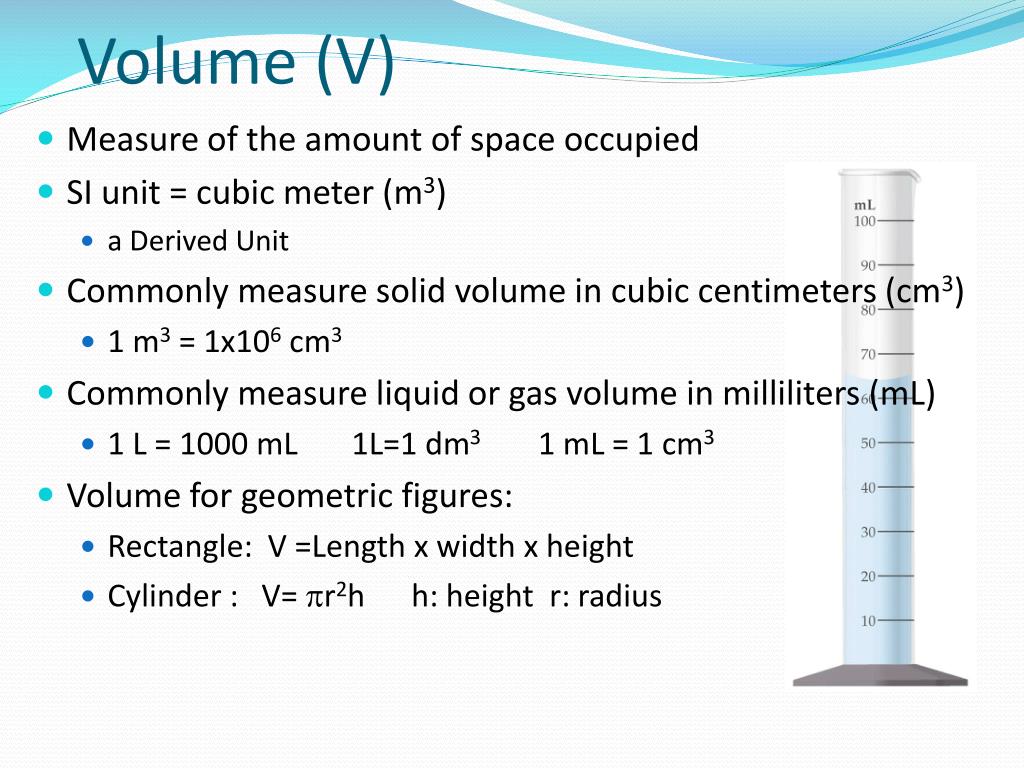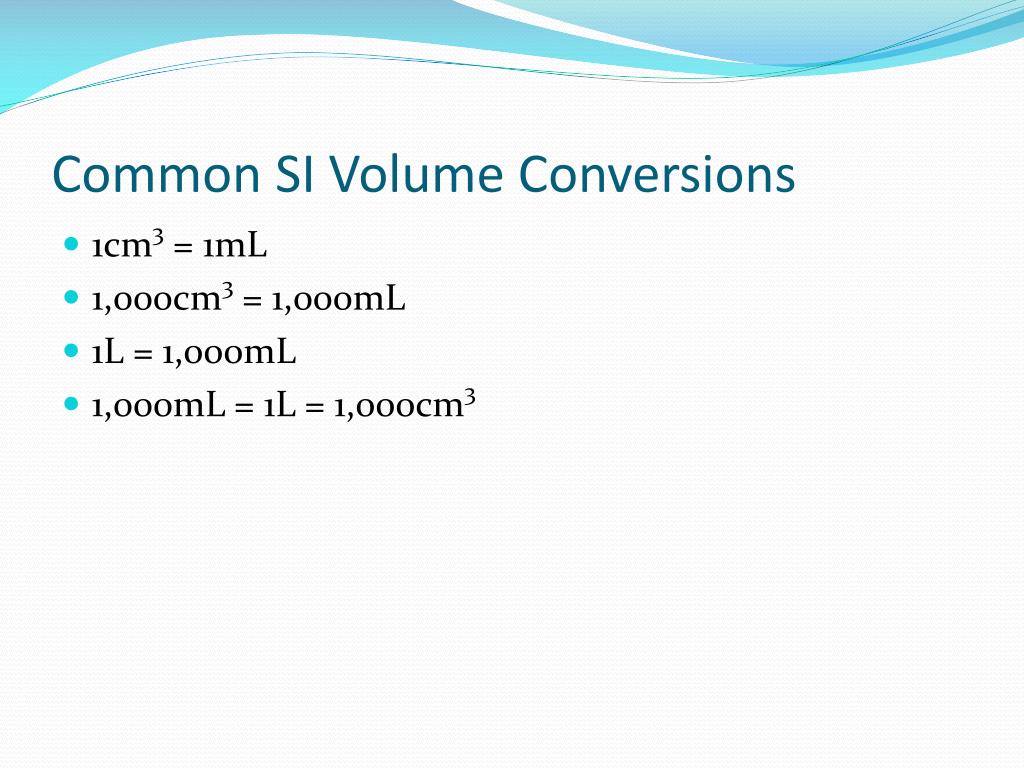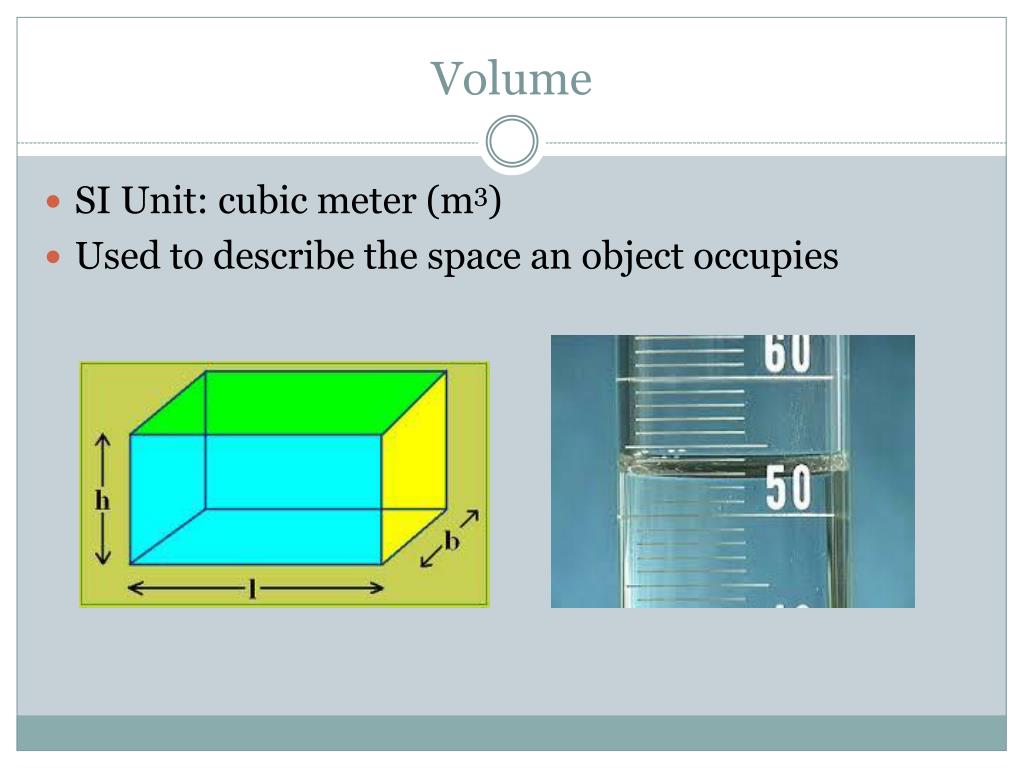
Volume Formulas Derivation, Examples
Volume is the measure of the amount of space occupied by an object. The standard SI unit of volume is defined by the base unit of length (Figure \(\PageIndex{3}\)). The standard volume is a cubic meter (m 3), a cube with an edge length of exactly one meter. To dispense a cubic meter of water, we could build a cubic box with edge lengths of.

PPT Volume SI derived unit for volume is cubic meter (m 3
This entry was posted on September 24, 2020 by Anne Helmenstine (updated on May 2, 2021) Volume definition and formulas for common shapes. Volume is defined as the three-dimensional space occupied by matter or enclosed by a surface. The SI unit of volume is the cubic meter (m3), but many units exist. Other volume units include the liter (L.

PPT Unit 7 PowerPoint Presentation, free download ID3193313
In the International System of Units or SI, the standard Unit of Volume is the cubic metre (m3). (Image will be uploaded soon) In the metric system, the Unit of Volume also includes the litre (L), where one litre is equal to the 10-centimetre cube. Therefore, 1 litre = (10 cm)3 = 1000 cubic centimetres. = 0.001 cubic metres, So, 1 cubic metre.

NASA Volume equation Civil Engineering Knowledge
Cubic meter (m 3) is an SI unit for volume. However, the term volume may also refer to many other things, such as the degree of loudness or the intensity of a sound; the number or amount of something (usually large quantity); and formal word for a book or one in a set of related books. Volume units and conversion table Popular units of volume are:

PPT Unit 2 PowerPoint Presentation, free download ID5440180
The base unit of volume in the SI system is the cubic meter (m 3).Other commonly used units of volume are the liter (L), the cubic centimeter (cm 3 or cc), and the milliliter (mL). One liter has a volume equal to 0.001 m 3.The nearest unit of comparable volume in the English system is the quart (1.000 L = 1.057 qt).

PPT Volume and Density in the SI System why things float or sink
candela per square meter. cd/m 2. mass fraction. kilogram per kilogram, which may be represented by the number 1. kg/kg = 1. For ease of understanding and convenience, 22 SI derived units have been given special names and symbols, as shown in Table 3. Table 3. SI derived units with special names and symbols.

Which table correctly identifies the SI units for length, mass, volume
A quantity in the general sense is a property ascribed to phenomena, bodies, or substances that can be quantified for, or assigned to, a particular phenomenon, body, or substance. Examples are mass and electric charge.

How to Calculate the Volume of a Cylinder 4 Steps (with Pictures)
SI Units - Length. The meter (m) is defined by taking the fixed numerical value of the speed of light in vacuum c to be 299,792,458 when expressed in the unit m s −1, where the second is defined in terms of ∆ν Cs. The meter was once defined by a physical artifact - two marks inscribed on a platinum-iridium bar, like these from the NIST.
/digital-illustration-of-showing-shape-and-volume-of-solid-gas--and-liquid-gas-taking-shape-of-conica-91284996-5ba786d2c9e77c0082827f47.jpg)
Specific Volume Definition, Formulas, Examples
The volume of a container is generally understood to be the capacity of the container; i.e., the amount of fluid (gas or liquid) that the container could hold, rather than the amount of space the container itself displaces. By metonymy, the term "volume" sometimes is used to refer to the corresponding region (e.g., bounding volume ). [2] [3]

Basic SI Units And Prefixes Chart Flinn Scientific
The International System of Units, internationally known by the abbreviation SI (from French Système International ), is the modern form of the metric system and the world's most widely used system of measurement.

PPT Volume SI derived unit for volume is cubic meter (m 3
Its seven basic units, from which other units are derived, were defined as follows: for length, the metre, defined as the distance traveled by light in a vacuum in 1/299,792,458 second; for mass, the kilogram, which equaled 1,000 grams as defined by the international prototype kilogram of platinum-iridium in the keeping of the International Bure.

The SI unit of volume is YouTube
A volume is a unit of measurement used to determine the volume or capacity of an object or the range of three-dimensional space. The cubic metre m3 m 3 is the S.I. unit of volume. However, numerous different units can be used to measure volume. In this Physics article, we'll look at a few more units of volume that are used to express volume.

PPT SI Units PowerPoint Presentation, free download ID2137989
2019. The ampere, symbol A, is the SI unit of electric current. It is defined by taking the fixed numerical value of the elementary charge e to be 1.602 176 634 × 10-19 when expressed in the unit C, which is equal to A s, where the second is defined in terms of ∆νCs. [26th CGPM, Resolution 1]

PPT SI Units PowerPoint Presentation, free download ID2237065
The International System Of Units (SI) is the metric system that is used universally as a standard for measurements. SI units play a vital role in scientific and technological research and development. It is made up of 7 base units which are used for defining 22 derived units.

PPT Chemistry Matter and Measurement PowerPoint Presentation, free
Thus the SI unit of volume is the cubic meter (m 3). This is rather large for use in the chemical laboratory, and so the cubic decimeter (dm 3) or cubic centimeter (cm 3, formerly cc) are more commonly used. The relationship between these units and the cubic meter is easily shown:

Symbols, SI units and common units for quantities in atmospheric
A unit of volume is a unit of measurement for measuring volume or capacity, the extent of an object or space in three dimensions. Units of capacity may be used to specify the volume of fluids or bulk goods, for example water, rice, sugar, grain or flour. Units According to the SI system, the base unit for measuring length is the metre.